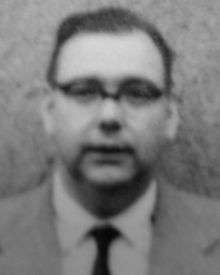Res Jost
Res Jost (10 January 1918 – 3 October 1990) was a Swiss theoretical physicist, who worked mainly in constructive quantum field theory.[1]
Res Jost | |
|---|---|
 Res Jost, Copenhagen 1963 | |
| Born | 10 January 1918 |
| Died | 3 October 1990 (aged 72) Zurich |
| Nationality | Swiss |
| Alma mater | University of Zurich |
| Scientific career | |
| Fields | Theoretical physics |
| Institutions | ETH Zurich |
| Doctoral advisor | Gregor Wentzel |
| Doctoral students | Sergio Albeverio Klaus Hepp Walter Hunziker Konrad Osterwalder David Ruelle Eduard Zehnder |
Life and work
Jost studied in Bern and at the University of Zurich, where he received his doctorate in 1946 under Gregor Wentzel ("Zur Ladungsabhängigkeit der Kernkräfte in der Vektormesontheorie ohne neutrale Mesonen“). He then spent half a year with Niels Bohr in Copenhagen, where he introduced the "Jost function" into scattering theory. Afterwards, he worked as an assistant of Wolfgang Pauli in Zurich. From 1949 to 1955, in 1957, 1962/3 and 1968 he was at the Institute for Advanced Study in Princeton, where he worked with Walter Kohn, Joaquin Mazdak Luttinger and Abraham Pais among others. From 1955, he was extraordinary professor for theoretical physics at ETH and starting from 1959 professor. In 1964, he and Rudolf Haag created the journal "Communications in Mathematical Physics “.
Jost established at the ETH a school of mathematical physics. Among his graduate students were Sergio Albeverio (b. 1939), Klaus Hepp (b. 1936), Konrad Osterwalder, David Ruelle, Robert Schrader, Eduard Zehnder, Rudolf Seiler, Martin Kummer.
Jost researched quantum-mechanical scattering theory (also inverse scattering theory: Reconstruction of potentials from scattering data) and the mathematical quantum field theory, where he in 1958 with the methods of Arthur Strong Wightman proved the PCT theorem and in 1957 introduced the Jost - Lehmann - Dyson - representation [2] (an integral representation of the expectancy value of the commutator of two field operators). Jost was corresponding member Austrian Academy of Sciences and United States National Academy of Sciences. He received in 1984 the Max Planck medal.
Jost married Viennese physicist Hilde Fleischer in 1949. One of his leisure activities was mushroom growing.
Works
- Jost: The general theory of quantized fields, AMS, 1965
- Jost: Das Märchen vom Elfenbeinernen Turm. Reden und Aufsätze, Springer 1995 (Herausgegeben von Klaus Hepp, u.a. über Physikgeschichte bei Planck, Einstein, Faraday, Dirac, Mach, mit biographischer Note von Abraham Pais und Autobiographischem von Jost), ISBN 3-540-59476-0
References
- Kohn, Walter; Ruelle, David; Wightman, Arthur (February 1992). "Obituary: Res Jost". Physics Today. 45 (2): 120–121. doi:10.1063/1.2809552.
- Jost, Lehmann: Integral representation of causal commutators , Nuovo Cimento Vol. 5, 1957, p. 1598, extended by Dyson Physical Review Vol. 110, 1958, p. 1960
Sources
- Abraham Pais: The Genius of Science, 2000.
- Arthur Jaffe For Res Jost and to Arthur Wightman, Communications in Mathematical Physics, Bd.134, 1990, Heft 1 (Wightman on Jost and Jost on Wightman)
External links
- Günter Scharf: Jost, Res in German, French and Italian in the online Historical Dictionary of Switzerland.
- Ray Streater zu Jost, in der er seinen Vorlesungen 1960 am IAS als Quelle für sein Buch mit Wightman seine Reverenz erweist